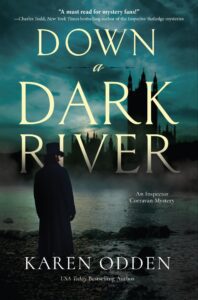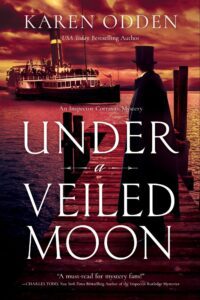
In this case truth and verisimilitude couldn’t be reconciled. On the one hand was some “common knowledge” about modern-day texting; on the other, some very “uncommon knowledge” about Churchill’s writing.
But what about less extreme instances?
As writers representing our fictional worlds (historical or not), sometimes we run up against readers’ assumptions or “common knowledge” about a period or place, which can range from slightly skewed to outright misinformation.
For example, after Down a Dark River was published, a reader complimented my detailed research, but said I had one important fact wrong: the Victorians drank tea, not coffee, as Corravan does. “There wasn’t a Starbucks on every corner like now,” she concluded, softening her criticism with, “LOL.”
I understand why this reader believes the Victorians only drank tea. Tea was a more common beverage
– although coffee had been a staple in the 18th century. Also, tea is ubiquitous in popular television and movies about England, from adaptations of Jane Austen’s novels to Ted Lasso. (Many readers lump Austen in with the Victorians, though she died twenty years before Victoria took the throne.) Tea also is a trope for the class-consciousness in Victorian England – with the aristocratic ladies sipping it, pinkies up, and the servants serving it.
However, the fact is that thousands of pounds of coffee were still making their way into London every year, and silversmiths were still crafting gorgeous coffee services in the 1870s.
This reader’s comment about the Victorians and tea gestured to a larger concern – namely, (when) should writers sacrifice or elide historical truth to keep the reader from tossing the book aside, saying, “Oh, that’s ridiculous”? Are there ways that I might cue a reader that what they believe about Victorian England might not be wholly accurate – without info-dumping and without “talking down” to the reader? I started keeping an eye out for how other authors do this, and I began incorporating techniques into my own books.
One easy possibility is to address the assumption directly. In the sequel,Under a Veiled Moon, I have Corravan mention that Harry Lish (who lives with him) likes tea, but Corravan can’t abide weak liquids in the morning. It cues the reader that I am aware that most people drink tea, and Corravan is just a bit contrary, in this, as he is in other things.
Another way is to have one character in the book stand in as the skeptic, holding a view that a reader might hold. This can result in two characters arguing (yay, conflict!), with one character finally proving that the counter-intuitive fact is correct. In Down a Dark River, Corravan and Dr. Everett argue about whether Madeline’s husband has the right to take her out of the hospital, against medical advice. Dr. Everett correctly insists that under the Victorian legal doctrine of coverture, the husband’s wishes always trump the doctor’s, even if the wife is profoundly ill – which surprised some readers.
I also use the Author’s Note at the end as my Get-Out-of-Jail-Free card for taking some liberties, such as moving a church from one part of London to another because I liked the church’s name and its true history of providing a home and services for reformed prostitutes.
One helpful practice is I ask beta-readers to put a “TV” in the margin when something might tug at the verisimilitude and feel unbelievable to a modern reader, or a reader who doesn’t know an unfamiliar setting.
The good news is that if the bulk of a book is demonstrably well-researched, creating a coherent and detailed world, it achieves the overall effect of verisimilitude, and writers can often get away with presenting a few unlikely facts. The important thing is to be mindful about the tension that produces and about when and why you’re going to insert it.
How do you handle this issue?
USA Today bestselling author Karen Odden received her PhD from NYU, taught at UW-Milwaukee, and edited for academic journals before writing fiction set in 1870s London. Her fifth novel, Under a Veiled Moon (2022), was nominated for the Agatha, Lefty, and Anthony Awards for Best Historical Mystery and features Michael Corravan, a former thief turned Scotland Yard Inspector. Karen serves on the national board of Sisters in Crime and divides her time between Arizona and Utah. Connect with her at www.karenodden.com
The post The Tension between Truth and Verisimilitude in Historical Fiction by Karen Odden first appeared on Debra H. Goldstein.
The post The Tension between Truth and Verisimilitude in Historical Fiction by Karen Odden appeared first on Debra H. Goldstein.

